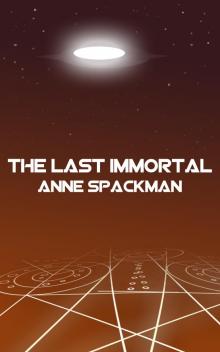- Home
- Anne Spackman
The Osiris Invasion: Book Two of Seeds of a Fallen Empire Page 2
The Osiris Invasion: Book Two of Seeds of a Fallen Empire Read online
Page 2
These greenhouse gases have raised global temperatures a few more degrees.
2169
As the temperature rose, carbon dioxide outgased from rock layers below the ocean. Once permanently trapped as carbolic acid at the great depths, this gas began to rise to the surface to add to the changing atmosphere.
The average Earth temperature has risen six degrees since the year 2000, and average precipitation had increased by 23% worldwide.
2170-2185
The dams built in the 2150’s to shield the coastal areas of California, New York, and parts of Western Europe from rising sea levels are subjected to storms of unprecedented ferocity and break at different times. Millions of people die in the destruction of Los Angeles and Rotterdam; these cities are not rebuilt.
Efforts to protect India, Bangladesh, China, and other parts of Southeast Asia from the rising ocean and global precipitation failed. 670 million people died in a string of sudden disasters.
In the United States, the two-party system has virtually ceased to exist. The Congress has been filled with a multitude of independent and special-interest representatives. A large minority group pressed to risk worldwide nuclear war and to militarily take over the last remaining oil fields in the Middle East. The Congress became paralyzed, and the President declared martial rule.
The governments of other once strongly democratic states such as England, Germany, France, and Japan have become significantly weakened by the burgeoning global disaster and can no longer provide stability and security for their people.
The Crisis Years have begun.
2185-2204
Average humidity continued to rise, but some areas experienced severe drought and desertification.
In 2187, during a period of severe drought and record high temperatures, almost the entire harvest of the American breadbasket region burned to the ground, producing a worldwide food shortage and mass starvation.
In 2188, spontaneous combustion destroyed the last of the ancient Redwood forest in Northern California.
The Black Forest burned down. The Ukrainian forests burned down. The woodlands of America's southeast burned down.
Over two thousand species of bird, insects, and mammals became extinct.
Four hundred species of aquatic life became extinct.
The rising worldwide temperatures have caused the glacial ice sheets to disappear.
The polar bear, sea lion, seal, and other northern species have disappeared from the North Pole, unable to adapt to the changes in their environment. A few remnants survived in wildlife preservation centers in northern Canada.
The Sahara desert expanded south to encompass the Sudan, Ethiopia, and the Congo.
By 2194, the global population was reduced to approximately 2.4 billion.
2205-2336
The world is gradually thrown into a dark age. Some small centers of culture and learning in survive in the North, where there is less threat of climactic upheaval.
Countless libraries, buildings, and cities in countries south of the Tropic of Cancer burn down. People revert to a more primitive existence in the most affected areas.
Once strong political states such as the United States, England, France, Germany, and Japan maintain a loose democracy but can no longer provide stability for their people. The voluntary positions of police regulators are taken by all kinds of power-abusive vigilantes.
Families lose contact with distant relatives as communication lines break down. Another factor for this is the growth of deserts and other new geographic obstacles.
Cities that catch fire burn down without permanent fire stations despite some organized and haphazard efforts to save them.
Transportation lines break down.
Electricity becomes rare.
Literacy declines, disappearing in the South nearly entirely.
Cholera epidemics sweep the southern cities.
Other political states are dominated by anarchy and individual self-interest.
2336 (1 AR)
A climactic analyst from the Scandinavian region named Inge Hellie proposed a plan to reverse the greenhouse effect.
By the time The Proposal is made, some degree of climactic stability has been achieved, primarily because the greenhouse effect is tapering off on its own; temperatures only marginally increase each year.
People are adapted to their present situation. Few know about The Proposal and fewer still attempt to contribute to the success of the plan.
Most of the people involved in the plan of Inge Hellie are the genetically unaltered classes of society living around the major northern political capitals and the wealth of knowledge from the past.
Word reaches the Americas and Asia after several years. There, a few groups send representatives on a long journey to Scandinavia by boat, something only the richer members of society had been able to do for the past century.
2347 (12 AR)
An International Committee on the Proposal is called to order. The bans on future detrimental actions if such a reversal could be affected, were put into writing for the first time.
Inge's proposal includes replenishing the ozone layer by an artificial chemical process that bound free chlorine ions with nitrous oxides and recombined diatomic oxygen with free oxygen to create ozone.
However, even after the ozone-accretion plan begins in 2253, it takes more than forty years to entirely filter the atmosphere and initiate a chain reaction.
In the northern regions, a plan to re-plant deforested land near water supplies means that constant supervision has to be maintained to fight possible fires.
2379 (44 AR)
The global temperature drops by a degree.
Species of plants and trees that have survived to the north are gradually being reintroduced to their native lands, and animals that have somehow survived throughout the years began to reappear in greater numbers around the newly re-forested zones.
A few people attempted to raise the Earth's albedo, or reflectiveness, by creating large reflective screens and placing them in the atmosphere with hot-air balloons, thus curtailing warming. But this method is only a temporary aid; it can do nothing to diminish the greenhouse gases in the air, notably carbon dioxide, which had instigated accelerated global warming in the first place.
Only the algae farms which appear at the end of the twenty-third century help decrease the actual carbon dioxide content in the air.
2431 (106 AR)
A German scientist by the name of Friedrich Hedelberg invents a means of converting large quantities of the carbon dioxide in the air into its component oxygen and carbon atoms by a catalytic process that released the oxygen and stored the solid carbon deposits. His ingenuity, added to the large-scale algae farms spreading across the planet, accelerates the rate of global cooling. Others replicate his filtering device across the world, but permanent changes come slowly.
2498 (173 AR)
Carbon dioxide falls to about 740 ppms (parts per million) in the atmosphere.
2500 (175 AR)
A study reports that the global temperature has dropped another three degrees since 2280.
There is a reawakening in culture across the world. The year 1 is dated from 2336AD, the year of Hellie’s Proposal. AR1 is called the year of the Restoration.
An international government is formed. One of the stipulations of the First International Committee was agreed upon by all of the nations, and the Earth was divided into zones: forested and natural zones, agricultural zones, and urban zones, so that never again can the Earth repeat its mistakes.
People must live in the urban zones. Food is grown in the agricultural zones. And the rural zones are forbidden, except for two week rural zone passes yearly. Human influence is reduced outside the urban zones by removing all urban materials, wastes, and structures from the territories in the vast rural areas.
The relocation of th
e world’s population to established and new urban zones takes half a century to carry out.
Only a select number of domed cities are to be built from 2500 on, eventually being linked to one another by closed transport tunnels. In between these zones, the committee creates the agricultural and rural zones.
Many historical cities are preserved as a part of these new urban zones, though some receive new names.
202 AR (2527 AD)
As the Earth's northern polar region begins to be restored to larger glacial sheets, once-flooded regions of the ancient coasts surface, to the delight of historians and archaeologists.
Archaeologists search to regain the knowledge lost in The Crisis Years. The northern centers are missing many ancient works and records.
Landfill archaeology is born.
The uncovering of the landfills dating back into the early twentieth century up until the twenty-second century provides a primary source of raw materials as well as information on history and technology.
Priceless plastics unavailable since the fossil fuels ran out centuries before are found. The landfills are rich in various non-biodegradable forms.
287 AR (2612AD)
New domed cities arise.
New forests are growing in the rural zones.
Pollutants and noxious gases have dropped in the atmosphere.
The air is said to taste as sweet as it once did before the industrial revolution, nearly a thousand years before.
Once-polluted seas and rivers are cleaned as best as possible.
The official end of The Crisis Years is announced.
The Restoration is still ongoing.
300 AR (2625 AD)
Scientific advancement progresses in leaps and bounds.
New institutes of scientific learning instigate a revival of twenty-second century technology. They redesign transports and other technologies to suit a more biologically and environmentally conscious society.
The world government becomes the United Earth Government, or the UEG.
The UEG creates a plan to restore the Earth's natural mineral and gaseous resources. The Earth intends to mine resources at Jupiter, and must build a space technology to do it.
Over the next 20 years, the UEG sends out mostly unmanned expeditions into outer space to collect raw materials and gases from other planets. Liquid nitrogen and oxygen is specifically wanted, since they are used as fuels in spacecraft and in new airborne “terrestrial” transports.
The Explorer and the Savior are lost in space. The third mission led by the manned ship Thea reaches Mars, Jupiter’s orbit, and Titan, a moon of Saturn.
375 AR-424 AR (2700AD-2749AD)
Colonies on the moon, on the large asteroid Ceres, on and above Titan, Mars, and finally, even on the surface of Pluto itself are established.
The plane and airborne transports become mass produced. Most people learn to fly them but rely day to day on automated piloting. On Earth, transport tunnels are used, and the use of planes over rural zones is kept at a minimum except by a fleet of several hundred patrolling recon squadrons.
The colonies serve a variety of functions including observation beyond the solar system, tracking of asteroids and other celestial objects, and a future launching point for the explorer probes sent to alpha centauri.
Automated government enterprises use these tellurian colonies to grow food in mineral-rich soils.
With the creation of automated labor, few colonists remain long in the new territories and only as overseers and intelligence specialists for jobs unsuitable to computer-run robotic machines.
There are still labor tasks the robots cannot do.
Ectogenesis (growing children in an artificial growing environment) is practiced for the first time since America’s legendary revolutionary experiments in ectogenesis, which date before The Crisis Years.
506 AR (2831AD)
The enormous rotating, orbiting space station Gabriel around the Earth is constructed.
507 AR-665 AR (2832AD-2990AD)
The Lagrange, an enormous zero g/microgravity multi-purpose station is launched to advance crystal and pharmaceutical production, taking the place of an abandoned ancient satellite left long ago in the same coordinates and several smaller satellites launched at the beginning of the twenty-eighth century.
The solar system colonies expand.
It is no longer necessary to work to live. Robots perform all minor labor tasks.
Most people do not work. Militant pacificism appears, since war and the need for it have disappeared since The Restoration.
Militant pacificists try to ban all nuclear uses, to prevent nuclear disasters occurring ever again to prevent war from being possible again.
A small ratio of highly motivated individuals works to advance science, art, and culture. The rest of the world live comfortably.
A manned mission to alpha centauri is planned. It will take centuries to make it possible, to create a spaceship that can take humankind to our neighboring solar system. Once the ship is nearly finished, a crew will have to be trained.
Nearly everyone on Earth can fly a transport and owns one kind or another.
Social restrictions are imposed on the population to prevent famine and poverty.
705 AR (3052 AD)
The technology now exists to create the alpha centauri mission ship, and construction of the Procyon begins. A search for future alpha centauri mission candidates among the staff of renowned scientific research bases is underway.
The Earth has at last nearly recovered from The Crisis Years. Only a few scarred deserts formed during The Crisis Years remain in the south of America and Asia. The Earth is thriving.
722 AR (3069AD)
An alien ship crashes on Earth and changes the course of human history.
Another alien ship appears and threatens the survival of the human race.
Our greatest test of survival has begun.
Chapter One
722 AR (3069AD)
UESRC laboratory 227:
Dr. Zhdanov, Head of Biochemistry at The United Earth Scientific Research Center and
Dr. Cameron, Head of Astrophysics at The United Earth Scientific Research Center
Maximum Security Research
"Are you absolutely certain that this is really an alien spaceship and that it will pass within our solar system?" The intonation of the question sounded more Ukrainian than the accent itself, though Zhdanov still tended to trill his R's.
"Pos-i-tive. Is Cameron there with you?" The image of Sullivan Dawe beamed at him on the communications screen. “Where is he?”
"Yes, he’s here, in the storage room, likely. Of course I'll pass the news on to him, but he won't like it." Zhdanov nodded, as Cameron himself came out of the storage room with a couple of boxes in his arms. "Try hailing it in every language you can think of, and get me some information—yesterday," Zhdanov added.
"Will do. I think Knightwood might already be trying the communications part." Dawe said. “The computers are doing everything we can think of.”
"Let us know every single detail of what's going on."
"What should I do about Arnaud?" Dawe asked. "He's about to bust a vein calling everyone in ASAP. No videocoms. He wants people in the Communications Center so they can be reached and monitored."
"Ummm, just tell him we'll be there soon." Zhdanov replied.
"Things are falling apart around here pretty darn fast, Zhdanov."
"I understand, and we'll be there as soon as we can." Zhdanov said.
With a quick motion in the air, Dr. Sergei Andreyevich Zhdanov deactivated the receiver of the intercom net by activating the manual override. Dawe's round face disappeared abruptly from the visual monitor, and Zhdanov withdrew, exhaling with deliberate control.
"Cameron?" Zhdanov called in his deep voice. He hadn't spoken to ascertain Camer
on's whereabouts; his colleague stood but a few meters away. Zhdanov had spoken to shake Cameron out of reverie and to attention, for once reversing the roles of their established relationship.
A silence hung in the air between them, made more noticeable by the persistent bubbling symphony of the surrounding test tubes and flasks. The older man waited, unmoving, his back turned to Zhdanov; Cameron stood leaning over the lab table. Then, with his back still turned, Cameron's shoulders began to heave. He pressed his palms flatter into the table.
"Snap out of it, don’t give me a reason to worry about you now," Zhdanov said. Cameron didn't answer. Zhdanov shook his head, unable to fathom his colleague's silence. He could not read his mind. Cameron's brain, as most high-ranking scientists, had mind control blockers, sensory augmentation chips, memory booster chips, and more hardware in his brain than a computer monitor.
"I'm fine, and I heard everything," Cameron offered after a moment. "Just give me a moment to catch my breath."
“Ok.” Zhdanov stood still, mutely watching Cameron's back. He then began to perceive that he understood what was wrong. Cameron couldn't handle the news. He was expecting the worst. But Cameron always expected the worst.
Zhdanov, on the other hand, believed it was better to withhold judgment until all of the facts were in, though he tended to be optimistic.
The human race had just got proof that life existed in the universe outside of the Earth. Maybe it wasn't an honor to find it out this way, rather than finding it, having it find them, but the discovery certainly was exciting, as long as it didn't prove fatal.
Alastair Cameron was sixty-five and had thick but fine brown hair with a few scattered grey hairs. Average life expectancy for a man these days was somewhere near a hundred and fifty, but few men ever made it to such an age with all of their original organs intact, much less their hair. At sixty-five and still in his prime, Cameron’s marvelous blue eyes were clear as glass and sharp as a hawk's (and every bit as intimidating), set above high cheekbones and a wide, tapering jaw.

 The Last Immortal : Book One of Seeds of a Fallen Empire
The Last Immortal : Book One of Seeds of a Fallen Empire Star Gods: Book Four of Seeds of a Fallen Empire
Star Gods: Book Four of Seeds of a Fallen Empire The Marsh of the Little Blue Heron
The Marsh of the Little Blue Heron Cormorant Bay
Cormorant Bay Across the Stars: Book Three of Seeds of a Fallen Empire
Across the Stars: Book Three of Seeds of a Fallen Empire Under the Ash Tree
Under the Ash Tree The Swan Gift
The Swan Gift Kestrel's Eye
Kestrel's Eye Caesar and Cleopatra: A Tale of Julius Caesar
Caesar and Cleopatra: A Tale of Julius Caesar The Road to Skye
The Road to Skye Juniper Hill
Juniper Hill The Empire: Book Six of Seeds of a Fallen Empire
The Empire: Book Six of Seeds of a Fallen Empire Days of Winter
Days of Winter The Osiris Invasion: Book Two of Seeds of a Fallen Empire
The Osiris Invasion: Book Two of Seeds of a Fallen Empire The Comet Riders: Book Five of Seeds of a Fallen Empire
The Comet Riders: Book Five of Seeds of a Fallen Empire Ocean Spirit : The Story of an Undine
Ocean Spirit : The Story of an Undine What Emma Left Behind
What Emma Left Behind The Book of Bird and Fairy Stories
The Book of Bird and Fairy Stories Blackberry Wine
Blackberry Wine Curse of the Dragon Kings
Curse of the Dragon Kings